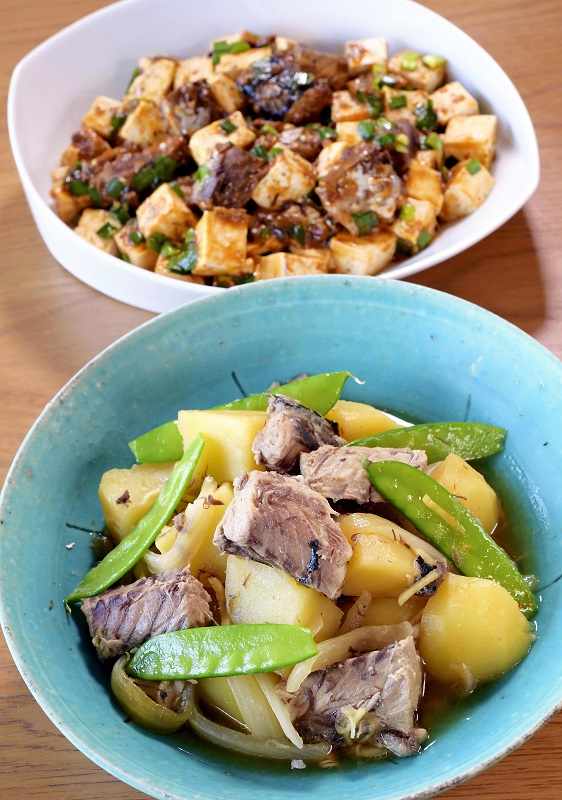
Mackerel and potatoes, foreground, and mackerel miso mapo tofu
11:38 JST, September 7, 2021
Canned mackerel is a lip-smacking staple in any pantry, popular for both its long shelf life and as a fortifying source of nutrients in a pinch — qualities that have encouraged many home cooks to stock up on the humble fish amid the pandemic.
Sakiko Kurose, a food stylist and “canned food researcher,” shared two simple recipes that will put those cans in your cupboard to creative use.
Rich in fatty acids such as EPA and DHA, which help prevent blood clots and reduce neutral lipid levels, mackerel has even overtaken tuna as Japan’s top canned fish by production volume in recent years.
While perfectly delicious eaten straight out of the can, Kurose said the fish also makes a versatile building block in dishes: “Mackerel’s umami and texture make it easy to pair with all kinds of ingredients. The possibilities are limitless.”
***
For her first dish, Kurose took a cue from nikujaga meat and potatoes, that hearty comfort food stew, mixing boiled spuds with mackerel canned in brine. By substituting the beef or pork that would normally be used in nikujaga with mackerel, the result is a lighter, cleaner feel that still hits all those gratifying umami notes.

Use the mackerel juice to extract all the nutrition and umami goodness from each can.
Kurose offered some tips to make the most of canned mackerel. First, the recipe calls for using all of the juice from the can, which is full of nutrition and flavor. But if the brine is too salty, you can use less and adjust as desired. Second, ginger helps counteract the fishiness of blue-backed fish like mackerel, giving the dish a refreshing flavor. Garlic can be substituted for ginger. Third, add the mackerel at the end to prevent the soft meat from falling apart as it cooks. As for the veggies, the snow peas provide an appealing splash of color, while the onions are for their appetizing moisture and sweetness.
Carrots cut into half-moons can be added as in classic nikujaga. But Kurose recommended keeping things simple, as too many add-ins will dilute the flavor.
Mackerel and potatoes
- Ingredients (serves 2):
- 1 can mackerel in brine (190 grams)
- 2 potatoes
- ½ onion (90 grams)
- 5 snow peas
- 1 piece of ginger, julienned
- 1½ tbsp mirin
- 1 tbsp soy sauce
- Directions:
- 1. Peel and cube potatoes into bite-size pieces. Cut onions into 1-centimeter slices.
- 2. Pour all the liquid from the mackerel can into a small saucepan, then mix in the julienned ginger, 120 milliliters of water, mirin and soy sauce. Add the chopped vegetables and set over medium heat. Bring to a boil, cover with a lid and simmer for 7 minutes.
- 3. Add the mackerel and simmer, covered with a lid, for another 3 minutes. Once the potatoes are cooked through, remove the lid and add the snow peas, cooking for about 1 minute.
***
For her second dish, Kurose prepared a rich mapo tofu using canned mackerel that has been simmered in miso. Canned mackerel in miso varies in flavor and intensity depending on the brand. Add a little water for a milder taste and a thinner soup.
The spiciness combined with the full-bodied miso flavor will whet your appetite and have you reaching for a bowl of white rice.
Mackerel miso mapo tofu
- Ingredients (serves 2):
- 1 can mackerel simmered in miso (190 grams)
- 1 block tofu (350 grams)
- 3 nira garlic chives
- 1½-2 tsp doubanjiang
- 1 tbsp sake
- 1 tsp katakuriko starch mixed with 1 tbsp water
- Ground Japanese sansho pepper
- Directions:
- 1. Cut the tofu into 2-centimeter cubes and chop the chives into 5-millimeter pieces. Leeks can be substituted for chives.
- 2. Put the mackerel and the liquid from the can into a pan. Add 4 tablespoons of water, sake and doubanjiang paste. Add tofu and cook over medium heat, stirring occasionally, for about 2 minutes.
- 3. Add ½ teaspoon of sesame oil and a mixture of water and katakuriko starch to the pan and cook about 1 minute until thickened, stirring continuously. Add chives and mix. Sprinkle with Japanese sansho pepper.
***
“Canned mackerel is a finished dish on its own, so it’s easy to dress up without fail,” said Kurose. “Even if you’re not a good cook, feel free to come up with a new side dish that will be at home on your family’s dinner table.”
"Features" POPULAR ARTICLE
-

Sanrio to Open Museum in Yamanashi Pref. Dedicated to Founder, Exhibits Include Hello Kitty, Other Characters
-

Autumn Foliage Surrounds Visitors to Tokyo’s Showa Kinen Park
-

My Daughter No Longer Speaks to Me, But I Want to See Her and My Grandchild
-

Kumamoto: Public Bath Refurbished as Library Where You Can Chat, Take Photos
-

Frozen Vegetables: Demand Rises for Convenient, Tasty Domestic Produce
JN ACCESS RANKING
-

Tokyo Economic Security Forum to Hold Inaugural Meeting Amid Tense Global Environment
-

Keidanren Chairman Yoshinobu Tsutsui Visits Kashiwazaki-Kariwa Nuclear Power Plant; Inspects New Emergency Safety System
-

Imports of Rare Earths from China Facing Delays, May Be Caused by Deterioration of Japan-China Relations
-

University of Tokyo Professor Discusses Japanese Economic Security in Interview Ahead of Forum
-

Japan Pulls out of Vietnam Nuclear Project, Complicating Hanoi’s Power Plans


























